The Immaculate Vibes of Barkeep on the Borderlands
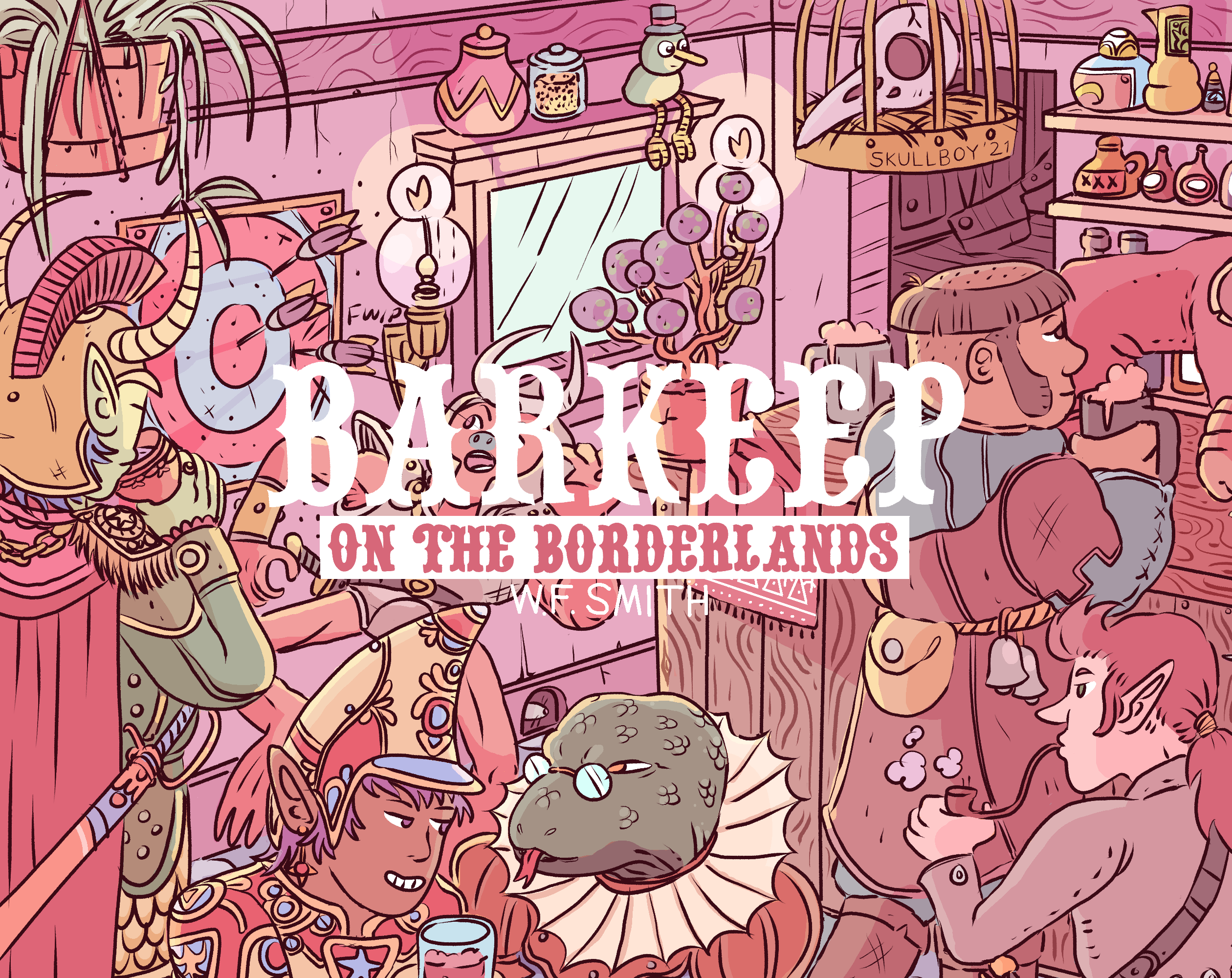
This is superficially a review of Barkeep on the Borderlands. But everyone knows it’s good. It won a bunch of awards, it’s written by a killer team, and the book is absolutely gorgeous. So we’ll get the review portion out of the way first.
The Review Portion Permalink
I ran a game of Barkeep for 4 sessions (and even made some cool coasters to use during play!). We entered less than half of the bars, and only made it to the end of day 2 (of 6). We could have played it for another 4-8 sessions but scheduling got difficult.
- Did we have deep character moments? A few.
- Did we explore strange places and loot awesome items? Yeah, a bit.
- Did we laugh? So hard that I had to take regular breaks.
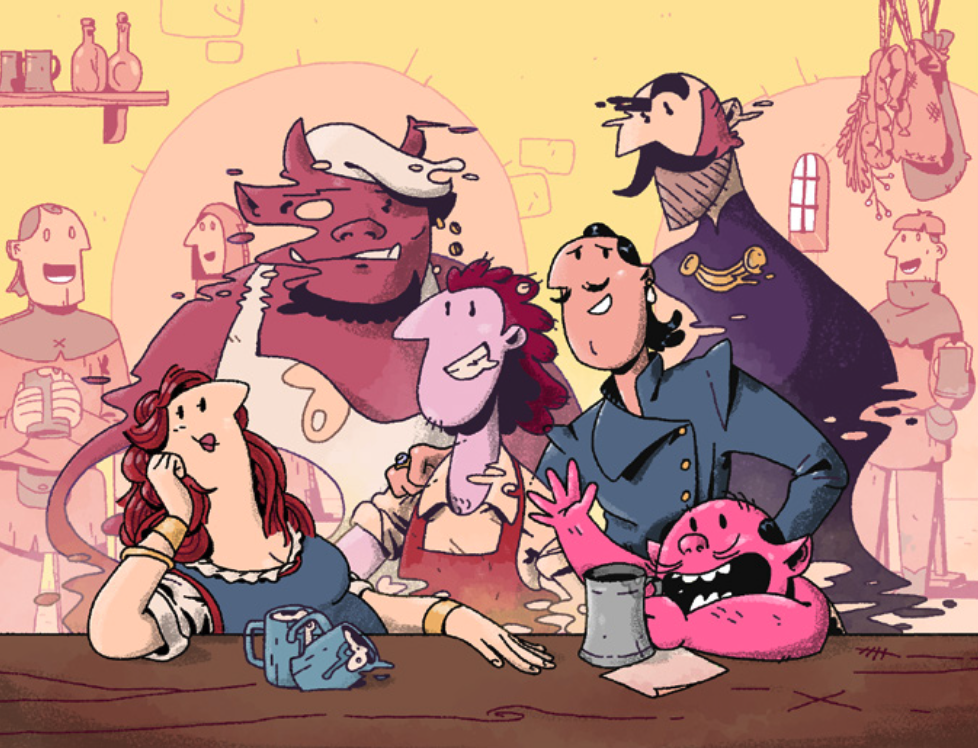
I can, without a doubt, say is the most I have ever laughed during any RPG campaign. Of course most of the credit goes to my very good friends who wholeheartedly embraced the immaculate vibes and amplified them with their own sensese of humor. But the books provided a very solid foundation of silliness and hilarity that cannot be understated (more on that later).
- A+. A unique concept excecuted beautifully. A breath of fresh air.
- 5 stars. The art and writing are superb.
- 9/10, because I think the drinking mechanics are a tad clunky. Everything else is perfect.
So What is This REALLY About? Permalink
In my Cloud Empress Review I said the tone of the game was something that engaged me and my players:
But more than that it was…melancholy. Not in a grimdark or maudlin kind of way. More like an old man refusing to tell a painful story.
And again with Barkeep, that consistent tone helped put our group in the right mindset. It was like having constant stage direction from the authors.

So this article is really about setting a tone in TTRPGs. I’m going to compare Cloud Empress, Barkeep, and a few others to pin down how they accomplish their respective vibes.
A Quick Look at Other Tones Permalink
Before we take a look at Barkeep, I want to drop a few quick examples to demonstrate how tone can be affected by writing, mechanics, art, etc. I firmly believe that the tone communicated by an RPG author is inteded to be replicated by the GM. So while you could run Blades in the Dark as a sexy dating game, I don’t think that would properly reflect the game’s tone.
Cloud Empress : grim, meloncholy, and vaguely hopeful Permalink
It uses horror game mechanics to drive tension and make the players feel that this world is dangerous. Even the mysterious chalk that powers your magic and gadgets is poisonous. Your character knows the spell “Lightning Blade”? I hope they never have to use it.
In truth, chalk is a pollutant. It sits heavy in the soil, creeping into the grass and the crops, and settling in the bones of deer-dogs and humans alike. Chalk crawls up the food chain, bleaching skeletons and withering bodies, before finding its way to the apex, to the Imago. Magic lives in the teeth. Frightened caregivers pull their children’s wisdom teeth young, cutting off magic at its roots. Each spell has a cost. All things in life have a cost. With every pleasure there is pain. The spell’s price is paid in full as soon as its effect has ended. You might be done with the spell, but the spell isn’t done with you, not by a long shot. – from the free Cloud Empress rulebook
Most locations have a strong tension between the different factions. The only peaceful places are the uninhabited ones.
A single house sits on a sandy hill, a skull painted on the door. An old woman, Worm, welcomes most visitors. Her hands tremble uncontrollably as she attempts to prepare tea. She seems confused, and any frustration quickly turns to violence. Worm feels no pain, her entire body having been taken over by the white fungus. Each digit, joint, and limb functions autonomously and must be destroyed separately to end the fight. Worm’s wounds expel a white dust and any severed fingers try to crawl into mouths and implant the infection. The Hounds’ Incense Burner (pg. 55) sits on a bookshelf near the kitchen. – from the Land of Cicadas
There is hope and beauty, but it has to be carefully extracted from a dangerous place. The mechanics, writing, and setting details all come together to drive home a strong tone. As a GM, this tone was easy to replicate and fall back on. I had little rules in my head:
- There is always a danger, probably unseen.
- Every benefit has a cost.
- People are hurting but hopeful.
- The Imago are unknowable.
- Soldiers are bastards.
The book taught me those lessons, and I carried that forward to the players.
Magical Murder Mansion : a deadly inside-joke Permalink
Let’s contrast this with an equally dangerous setting with a drastically different tone: Magical Murder Mansion.

You can read my review here, but I’d argue the primary tone of this adventure is set by the author himself during the introduction:
Some of the traps in classic funhouse dungeons seem like jokes designed for the module’s author and the GM to share, with the poor players left frustrated and baffled. I’ve tried to make Magical Murder Mansion entertaining for everyone; even the deathtraps and surprises should get an joyful “oh no, I can’t believe we walked into that one” from the players. The GM knows it’s a trap. The players know it’s a trap. But someone’s got to open that door. – Skerples introducting the adventure
Without that introduction I think the humor would take a little longer to emerge from the book. “Wait…is he serious?” would get asked a few times before the group finally realizes that this is supposed to be silly.
Some rooms actually are filled with jokes (like a stuffed lion with “not a mimic” scrawled on it), and some rooms are just outrageous death traps. And while the characters are probably suffering horribly, the players are likely chuckling along with each damage roll.
I also think a big part of the humor comes from a familiarity with dungeon crawls. If this was someone’s first dungeon crawl they might not get some of the jokes.
But Magical Murder Mansion successfully uses subtle clues to provide an undercurrent of humor in the middle of a diabolical deathtrap adventure.
Bones Deep : Evey saves the day Permalink
Bones Deep has some grim elements that were very strong in the early drafts. We had cursed wizard rivalries, creepy underwater monsters, and skeleton body horror. Even the Crab Cabal used to be more nefarious (with far crueler punishments for going into too much debt).
However we really struggled with the “miens” of each creature. In Troika every creature has 6 potential “miens” or moods or temperments. I couldn’t get them right; either they felt too boring (“angry”, “sad”, “hungry”) or they were too confusing (how can a fish be “filled with revenge”). I ended up reaching out to Evey Lockheart, who is a brilliant Troika wizard.
She took each of our creatures and spiced them up with some of the most engaging, creative, and silly miens I’ve ever seen. While she wrote less than 2% of the book, her contributions brought a massive amount of levity and life to each creature. Each mien impacts the scenarios during play. I credit Evey with a big chunk of what makes Bones Deep such a fun and appealing adventure for people to play.

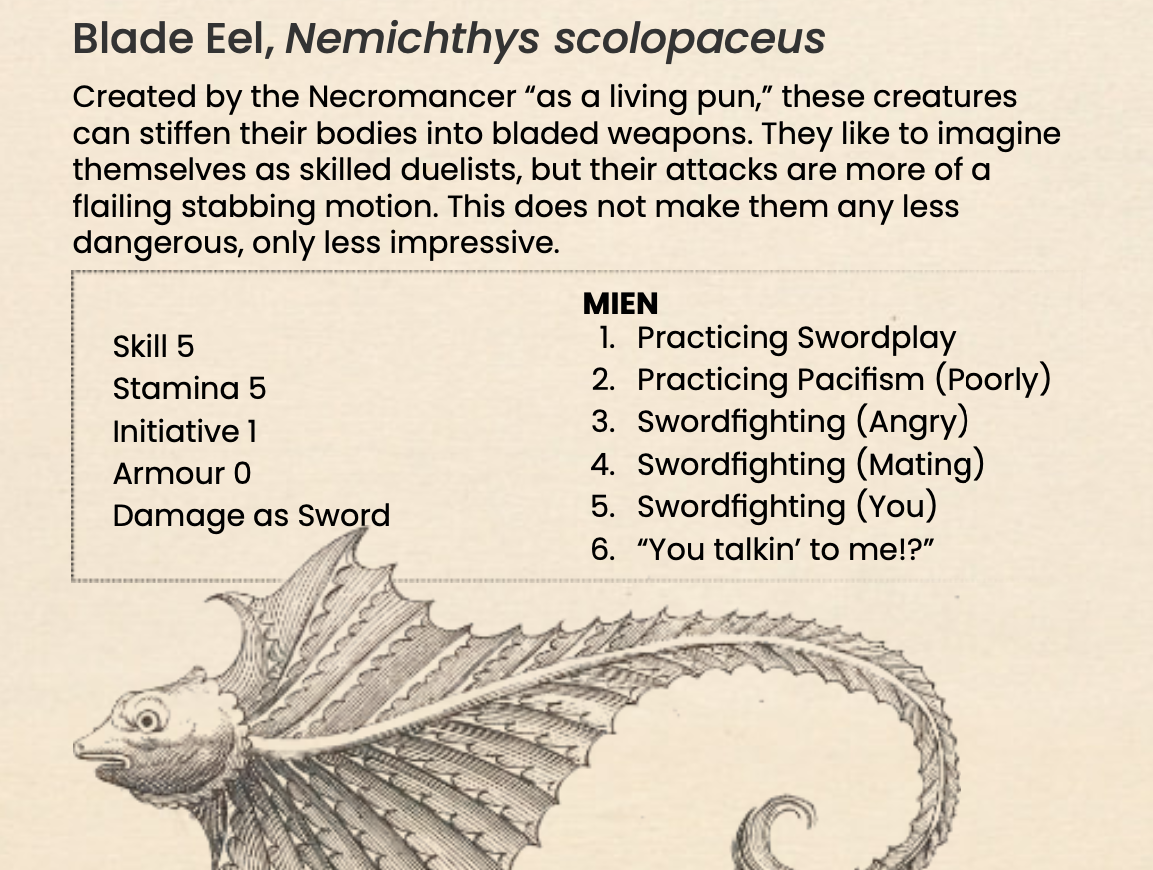
Sometimes the tone can be affected by the smallest details of an adventure.
What About Barkeep? Permalink
So we’ve looked at a book where the tone is repeated by its art, its writing, and its content. We looked at a book where the tone is subtly growing stronger throughout the adventure. And we saw how a small part of a book can drastically impact its final tone.
As we look at Barkeep, keep in mind that this book has 12 writers and 3 editors! It must have been a significant challenge to keep everyone on the same page with the same goals.
Since lists help me organize my thoughts, I’ve come up with three ways that Barkeep maintains a lighthearted and uplifting tone:
1) Cartoonish Drinking Permalink
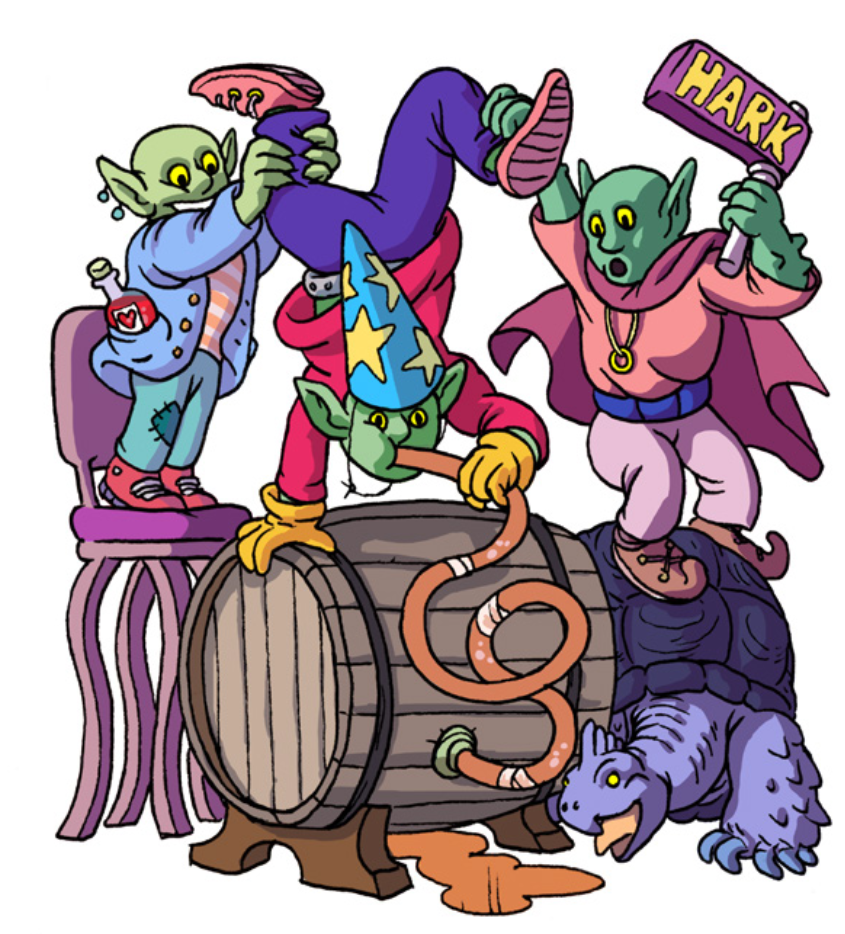
This was a big one, and the detail that prompted me to write this article.
I don’t drink very often, and I hate the feeling of being drunk. I also have a few close friends who have endured a lot of pain related to alcohol addiction. Alcohol is not a silly or light-hearted thing for me, and I was worried that Barkeep would be kind of dark and miserable (since drinking alcohol can sometimes be dark and miserable).
But it’s not! Barkeep has a very cartoonish perspective on alcohol. Less “throwing up in your ex’s bathroom” and more “getting the hiccups and dancing naked in the backyard”, if that makes sense. In fact it goes out of its way to avoid any kind of misery or alcoholic angst. Here are a few drunk examples:
A patron drunkenly mistakes a PC for the owner, thanks them for their hospitality and apologizes for some catastrophe in a bedroom. 1 Turn later, a porter arrives with a barrel of fine ale but needs the owner of the apartment to sign for it to leave it there.
A street preacher of Chaos targets the soberest PC, righteously angry that they are not drunk enough.
Parliament motions to eject the drunkest PC. They are dragged to the lectern to argue against their ejection.
A drunk wizard tried to order a hurricane but errantly summoned an air elemental. It rampages in search of an exit.
All of these scenarios present being drunk like being confused or silly. It side-steps the darker cliches of alcohol and keeps things light. You never see anyone crying into a bottle of wine, or begging for one more drink; instead the scenario is always played for comedy.
Just to be clear, I think this is A Good Thing™. I’m sure there’s a place for criticizing alcohol abuse and portraying the dangers of addiction…but Barkeep is not trying to be that at all. It wants to be a silly adventure for goofing around with your friends, and in that it succeeds by focusing on the fun.
2) Low Stakes Permalink
The big hook of the adventure is that the Monarch will die if the players don’t explore the city and find the missing cure. But the adventure points out that the Heir is quite capable, and maybe even a good leader. If the party fails, the world won’t end, it’s unlikely anyone will suffer, and in fact most people won’t even notice or care.
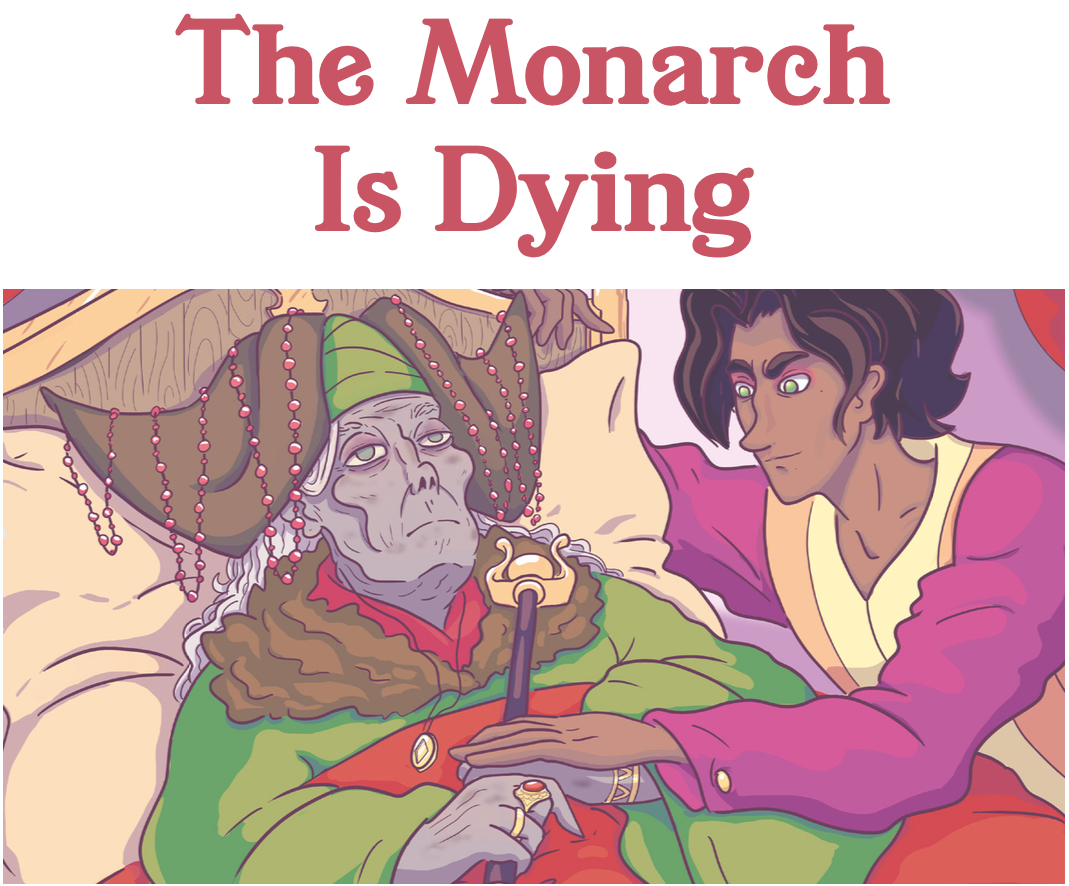
Even the usual adventure lose condition of “horrible death” isn’t very likely. Instead Barkeep relies on a drinking mini-game and a ticking clock to drive tension. If the characters get too drunk, the day ends and they wake up the next morning hungover. They only have six days to find the antidote.
This means that an encounter like “being challenged to a dance-off” is actually a meaningful decision. Is this worth our time? Can we win? It’s a nice breath of fresh air when every other adventure asks “Can you survive?” and Barkeep wonders, “Can you out-drink a lich?” (spoiler: you can’t).
3) Comedy Bits VS Deadly Threats Permalink
A lot of comedy games treat you to silly situations and scenarios, hoping the players will find them funny. “Oh look at this outrageous scenario! Isn’t it funny?” By contrast, Barkeep makes you a part of the joke itself. It ‘s like every encounter is the start of an improv comedy bit, begging you to join in.
There are 20 bars in the book, and each bar has over a dozen encounters. Instead of rolling randomly, I usually choose encounters that seem like the most fun. And it was VERY hard to choose! Just look at these:
A friendly stranger offers a PC (roll d6): (1-2) a pouch of pipeweed for just 1d6 gold coins, (3-4) a knife between the ribs, (5-6) a swift kiss amidst the bushes.
Seniors demand all patrons pour their drinks and potions into a cauldron for a hazing ritual. Desperate freshmen beg the PCs to drink it instead of them.
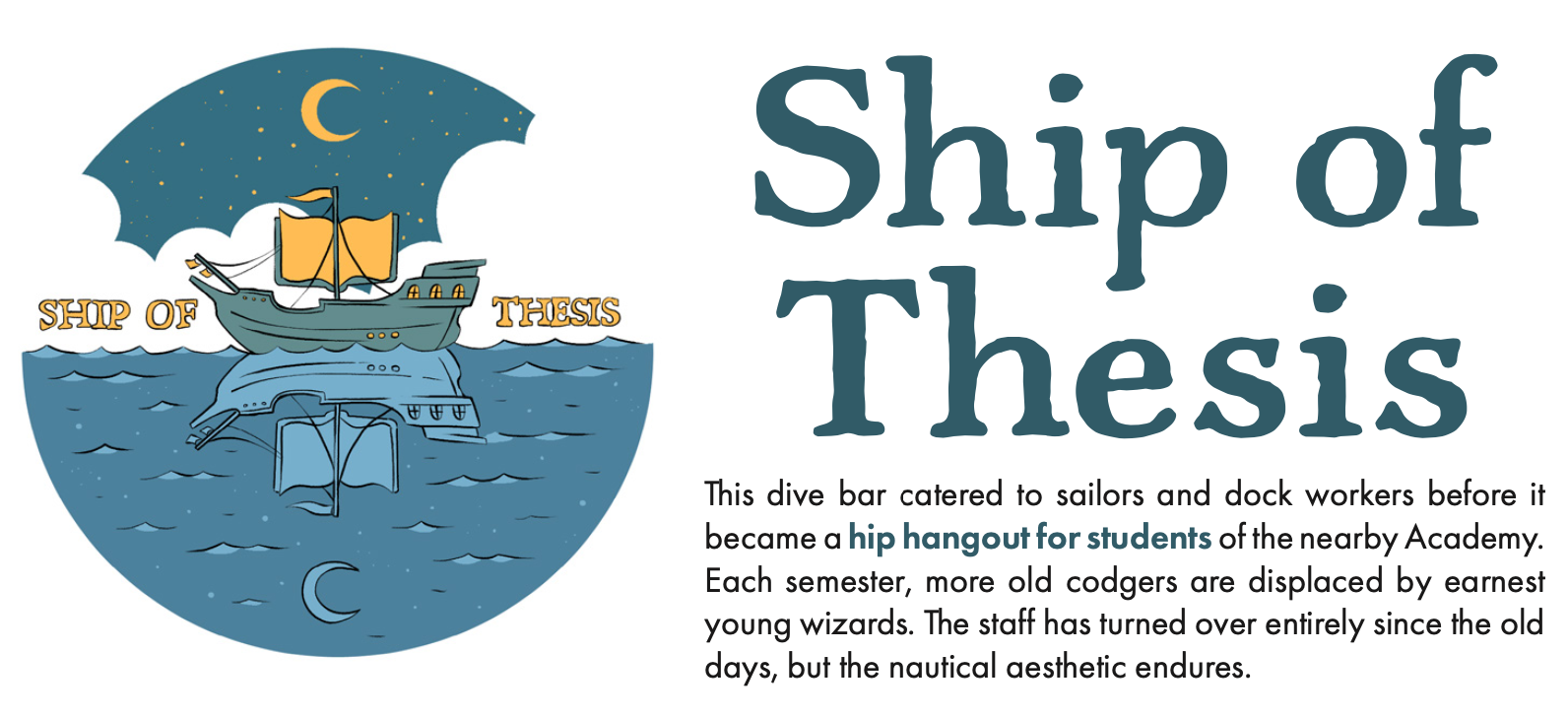
A cowled coven of parliamentarians holds a debauched cult initiation. “One of us!” Their leader, a lizardfolk in disguise, hands a paddle to a PC.
A PC is challenged to a deathmatch by a future version of themselves. If they win, they’ll join the PCs. They have (roll d6): (1-2) a crab claw for a hand, (3-4) a mechanical eye, (5-6) a child.
A reverse thief tries to place 20 gold coins into a jolly crewmate’s pockets. There is a 5-in-6 chance they get caught in the act.
A goblin who believes a long beard is all that’s needed to cast spells. They demand any bearded jolly crewmate teach them how.
Okay, I have to stop. I literally have a dozen more I want to share, but you get the idea. Buy the book for yourself and enjoy them all!
Each one of these is inviting the PCs to engage with it, either to join in the fun or to cause a scene by refusing (or both). Most aren’t traditional threats but instead are awkward or bizarre situations. And thanks to that ticking clock, they can even have stakes and some lighthearted drama.
I dare you to play through Barkeep and maintain a serious tone or attitude amidst these colorful encounters.
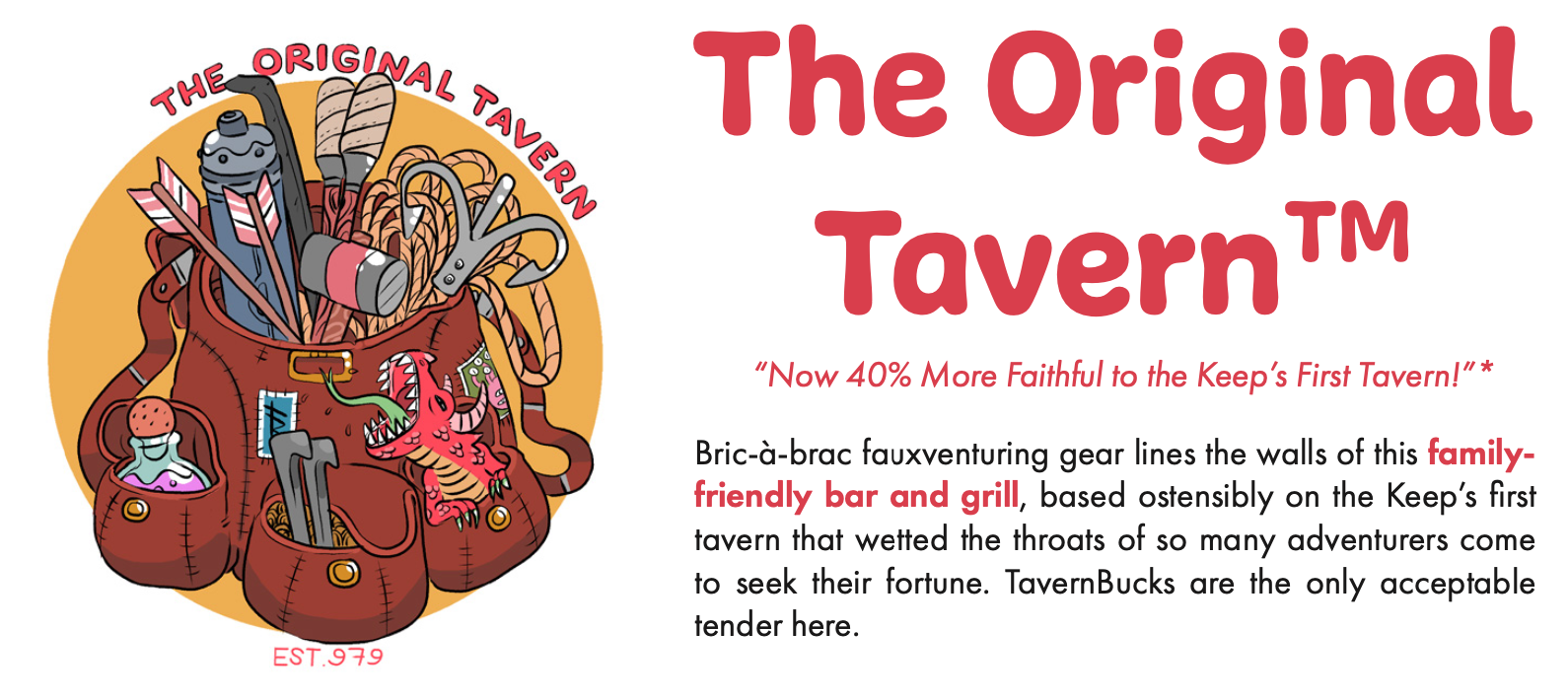
Conclusion Permalink
Barkeep is damn good. It’s a masterclass of setting a very specific tone and reinforcing it with each random encounter. It side-steps the harsher realities of alcohol, inviting the players to drink deeply of it’s silly vibes.
If you need something a bit lighter for your table, you can’t do any better than Barkeep.
hiccup
One more, please!
A Chaser Permalink
I hated the drinking mechanics of Barkeep. Our group still had a blast, but here’s a short rant from someone who thinks too much about RPG mechanics.
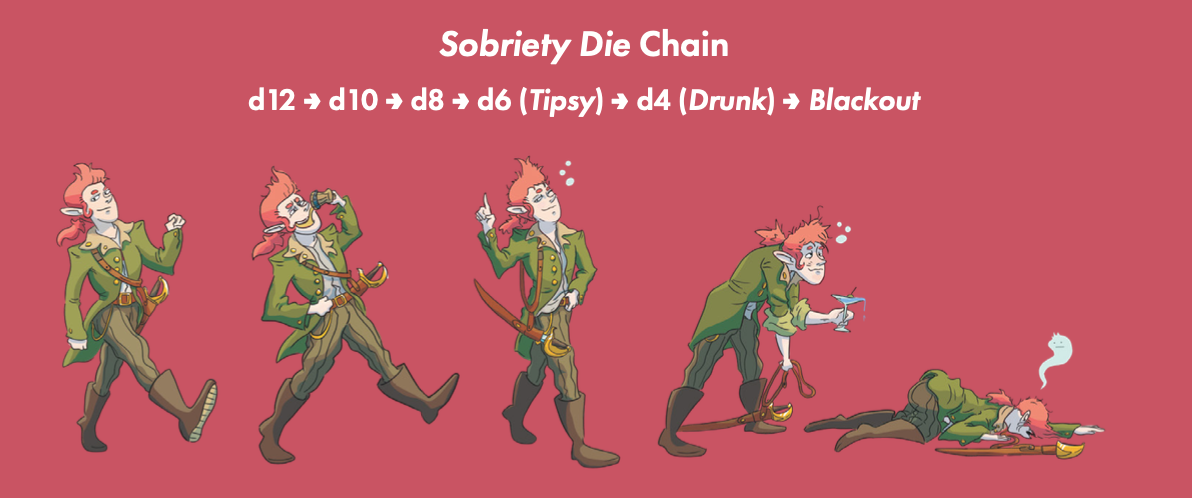
The actual drinking rules have more examples and explanations, but here’s my summary:
- The GM describes the current situation.
- Each player takes an action, or the group acts together.
- Each player rolls their Sobriety Die (see image above)
- The GM describes the outcome of their actions.
- The GM rolls a d6.
- 1, 2 - A random encounter
- 3, 4 - Buy a new drink and roll Sobriety Die again. If drinking water, increase Sobriety Die size by one step.
- 5, 6 - An hour passes.
I have a few problems with these rules:
Encounters Are Rare, and I relied on them to engage players in the bar or to fill dead time. If I followed these rules then I would only use the written encounters 33% of the time. Blech. It also was weird to roll encounters AFTER players made their choices. I prefer to present the encounter first, and let players react to that.
Hard to Sober Up. Being a little drunk (d6/d4 Sobriety Die) actually has a few benefits, so players want to ride that line between blackout and sober. Which is neat! But it’s very hard to sober up. You have to decide to drink water BEFORE 3, 4 are rolled by the GM, and drinking water makes the bar hostile to you (since you’re taking up a seat that someone could be drinking in). So even if a player chooses to drink water, they will still be getting drunker and it might be a few turns before the GM rolls that option.
Here’s my solution, and what I ended up using for my games:
- The GM describes the current situation. If things are slow, roll an encounter.
- Each player can take an action, or the group can act together.
- Each player rolls their Sobriety Die (see image above).
- The GM describes the outcome of their actions.
- The GM flips a coin:
- Heads - One hour passes.
- Tails - Players finish their drinks. They either buy another drink (1d6 silver) or they buy food (2d6 silver) and upgrade their Sobriety Die one step.
This gives players a choice to make, and the Sobriety Die is still being rolled each turn. I might even make a big d20 table of random bar food that can be purchased. Also I love flipping coins.
Anyway, that’s a very minor gripe. Your mileage may vary.
